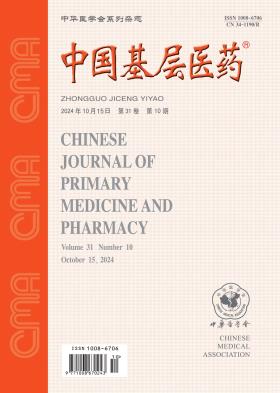Analysis of the effect and safety of levonorgestrel-releasing intrauterine system on patients with breast cancer who take tamoxifen
引用次数: 0
Abstract
Objective To analyze the effect and safety of levonorgestrel-releasing intrauterine system(LNG-IUS) for the premenopausal patients with breast cancer who took tamoxifen as adjuvant therapy. Methods From June 2014 to June 2016, 84 patients with breast cancer who met the inclusion criteria in the First People′s Hospital of Xiaoshan District were randomly divided into two groups according to the digital table.The treatment group (39 cases) underwent LNG-IUS insertion, while the control group (45 cases) received no LNG-IUS insertion.The general condition of patients before the use of tamoxifen and LNG-IUS was evaluated.Transvaginal ultrasound was used to measure the thickness of endometrium, hysteroscope was used for pathological examination of endometrium and the measurement of ER/PR expression, and blood lipid level was also detected.All above was done before the treatment of tamoxifen and LNG-IUS, 1 year after treatment and 2 years after treatment. Results Before the therapy, there were no statistically significant differences between the two groups in general condition and uterine cavity condition(all P>0.05). After 1 year, the incidences of endometrial polyp, endometrial hyperplasia/secretion, benign lesion and endometrial atrophy in the treatment group were 2.6%, 5.1%, 15.4%, 76.9%, respectively, which in the control group were 6.7%, 20.0%, 17.8%, 55.6%, respectively.the differences between the two groups were statistically significant(χ2=4.06, 4.22, all P<0.05). After 2 years, the incidences of endometrial polyp, endometrial hyperplasia/secretion, benign lesion and endometrial atrophy in the treatment group were 0.0%, 2.6%, 84.6%, respectively, which in the control group were 11.1%, 15.6%, 60.0%, respectively, the differences between the two groups were statistically significant(χ2=4.608, 4.092, 6.203, all P<0.05). Conclusion LNG-IUS can prevent the benign endometrial lesions of breast cancer patients caused by tamoxifen therapy after surgery, and can decrease the incidence of endometrial polyp and endometrial hyperplasia/secretion, while increase the incidence of endometrial atrophy, without increasing the recurrence risk of breast cancer. Key words: Intrauterine devices, Medicated; Levonorgestrel; Tamoxifen; Breast neoplasms; Premenopause; Endometrium左炔诺孕酮释放宫内系统对乳腺癌患者服用他莫昔芬的疗效及安全性分析
目的分析左炔诺孕酮缓释宫内节育器(LNG-IUS)对癌症绝经前患者应用他莫昔芬辅助治疗的疗效和安全性。方法2014年6月至2016年6月,将萧山区第一人民医院符合入选标准的84例癌症患者按数字表随机分为两组。治疗组(39例)植入LNG-IUS,对照组(45例)未植入LNG-IUS。评估患者在使用他莫昔芬和LNG-IUS前的一般情况。经阴道超声检测子宫内膜厚度,宫腔镜检查子宫内膜病理及ER/PR表达,同时检测血脂水平。以上均在三苯氧胺和LNG-IUS治疗前、治疗后1年和治疗后2年进行。结果治疗前两组子宫内膜息肉、子宫内膜增生/分泌、良性病变和子宫内膜萎缩的发生率治疗组分别为2.6%、5.1%、15.4%、76.9%,对照组分别为6.7%,两组间差异有统计学意义(χ2=4.06,4.22,均P<0.05)。2年后,治疗组子宫内膜息肉、子宫内膜增生/分泌、良性病变和子宫内膜萎缩的发生率分别为0.0%、2.6%、84.6%,对照组分别为11.1%、15.6%、60.0%,结论LNG-IUS可预防乳腺癌症患者术后因三苯氧胺治疗引起的子宫内膜良性病变,降低子宫内膜息肉和子宫内膜增生/分泌的发生率,增加子宫内膜萎缩的发生率,而不会增加癌症的复发风险。关键词:宫内节育器,药物;左炔诺孕酮;三苯氧胺;乳腺肿瘤;绝经前;子宫内膜
本文章由计算机程序翻译,如有差异,请以英文原文为准。
求助全文
约1分钟内获得全文
求助全文
来源期刊
CiteScore
0.10
自引率
0.00%
发文量
32251
期刊介绍:
Since its inception, the journal "Chinese Primary Medicine" has adhered to the development strategy of "based in China, serving the grassroots, and facing the world" as its publishing concept, reporting a large amount of the latest medical information at home and abroad, prospering the academic field of primary medicine, and is praised by readers as a medical encyclopedia that updates knowledge. It is a core journal in China's medical and health field, and its influence index (CI) ranks Q2 in China's academic journals in 2022. It was included in the American Chemical Abstracts in 2008, the World Health Organization Western Pacific Regional Medical Index (WPRIM) in 2009, and the Japan Science and Technology Agency Database (JST) and Scopus Database in 2018, and was included in the Wanfang Data-China Digital Journal Group and the China Academic Journal Comprehensive Evaluation Database.

 求助内容:
求助内容: 应助结果提醒方式:
应助结果提醒方式:


